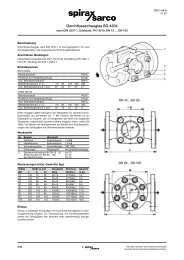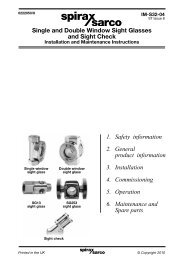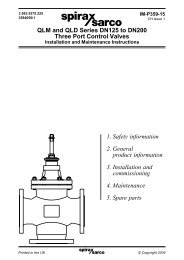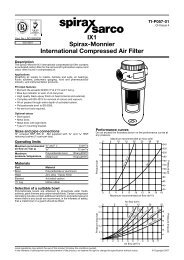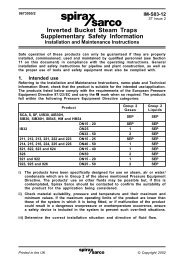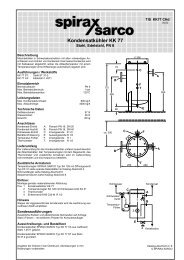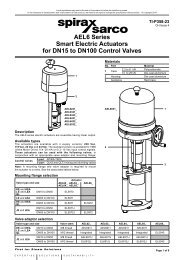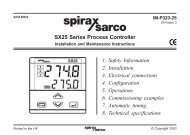2000 Hook-up Book - Spirax Sarco
2000 Hook-up Book - Spirax Sarco
2000 Hook-up Book - Spirax Sarco
You also want an ePaper? Increase the reach of your titles
YUMPU automatically turns print PDFs into web optimized ePapers that Google loves.
SYSTEM DESIGN<br />
4<br />
Sizing Steam Lines On Velocity<br />
Fig. 1 lists steam capacities of<br />
pipes under various pressure and<br />
velocity conditions.<br />
EXAMPLE: Given a steam heating<br />
system with a 100 psig inlet<br />
pressure ahead of the pressure<br />
reducing valve and a capacity of<br />
1,000 pounds of steam per hour<br />
at 25 psig, find the smallest sizes<br />
of <strong>up</strong>stream and downstream piping<br />
for reasonable quiet steam<br />
velocities.<br />
Upstream Piping Sizing<br />
Enter the velocity chart at A for<br />
1,000 pounds per hour. Go over<br />
to point B where the 100 psig<br />
diagonal line intersects. Follow <strong>up</strong><br />
vertically to C where an intersection<br />
with a diagonal line falls<br />
inside the 4,000-6,000 foot-perminute<br />
velocity band. Actual<br />
velocity at D is about 4,800 feet<br />
per minute for 1-1/2 inch<br />
<strong>up</strong>stream piping.<br />
Downstream Piping Sizing<br />
Enter the velocity chart at A for<br />
1,000 pounds per hour. Go over<br />
to point E where the 25 psig diagonal<br />
line intersects. Follow <strong>up</strong><br />
vertically to F where an intersection<br />
with a diagonal line falls<br />
inside the 4,000-6,000 foot-perminute<br />
velocity band. Actual<br />
velocity at G is 5,500 feet per<br />
minute for 2-1/2 inch downstream<br />
piping.<br />
Pressure Drop in Steam Lines<br />
Always check that pressure drop<br />
is within allowable limits before<br />
selecting pipe size in long steam<br />
mains and whenever it is critical.<br />
Fig. 2 and Fig. 3 provide drops in<br />
Sch. 40 and Sch. 80 pipe. Use of<br />
the charts is illustrated in the two<br />
examples.<br />
EXAMPLE 1<br />
What will be the smallest schedule<br />
40 pipe that can be used if<br />
drop per 100 feet shall not<br />
exceed 3 psi when flow rate is<br />
10,000 pounds per hour, and<br />
steam pressure is 60 psig?<br />
Solution:<br />
1. Find factor for steam pressure<br />
in main, in this case 60<br />
psig. Factor from chart = 1.5.<br />
2. Divide allowable pressure<br />
drop by factor 3 . –. 1.5 = 2 psi.<br />
3. Enter pressure drop chart at<br />
2 psi and proceed horizontally<br />
to flow rate of 10,000<br />
pounds per hour. Select pipe<br />
size on or to the right of this<br />
point. In this case a 4" main.<br />
EXAMPLE 2<br />
What will be the pressure drop<br />
per 100 feet in an 8" schedule 40<br />
steam main when flow is 20,000<br />
pounds per hour, and steam<br />
pressure is 15 psig?<br />
Figure 1: Steam Velocity Chart<br />
Solution:<br />
Enter schedule 40 chart at<br />
20,000 pounds per hour, proceed<br />
vertically <strong>up</strong>ward to 8" pipe curve,<br />
then horizontally to pressure drop<br />
scale, read 0.23 psi per 100 feet.<br />
This would be the drop if the<br />
steam pressure were 100 psig.<br />
Since pressure is 15 psig, a correction<br />
factor must be used.<br />
Correction factor for 15 psig = 3.6<br />
0.23 x 3.6 = 0.828 psi drop per<br />
100 feet for 15 psig




